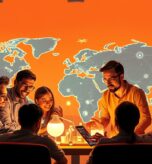The professional landscape is transforming faster than ever. By 2028, 73% of workgroups will include virtual team members, according to recent workforce studies. This shift creates exciting possibilities for creative professionals—especially those specializing in user-centered digital experiences.
What began as temporary remote arrangements has evolved into a permanent revolution in how companies operate. Organizations now prioritize flexible talent solutions, with hybrid models balancing office collaboration and home-based efficiency. For skilled creators shaping digital interactions, this change unlocks access to global projects without geographical constraints.
At Tree9, we specialize in building high-performing distributed teams that drive results. Our approach helps businesses reduce operational costs while connecting them with top-tier professionals. Whether you’re an experienced specialist or entering the field, understanding these evolving dynamics positions you for success.
This guide explores actionable strategies for thriving in tomorrow’s digital workspace. You’ll discover emerging platforms, learn how to showcase your skills effectively, and gain insights into market trends shaping hiring decisions. We’ll also reveal how modern staffing solutions simplify finding roles that match your expertise and career goals.
Overview of the Remote UX Designer Job Market
The digital workspace revolution has reshaped creative careers. Over 36 million Americans will work virtually by 2025, with nearly 1,000 UX roles currently listed across major platforms. This surge reflects fundamental changes in how businesses approach design talent.

Evolving Trends and Market Insights
Employers now prioritize skills over location. Financial institutions and healthcare organizations lead remote hiring, alongside tech giants and automotive innovators. Small firms drive this shift—they’re twice as likely to offer fully virtual positions than large corporations.
Current data shows unprecedented demand across sectors. E-commerce brands seek specialists to optimize checkout flows, while software companies need interface experts. This diversity creates opportunities for niche skills like accessibility design or AI-driven prototyping.
Impact of Remote Work on UX Careers
Geographical barriers have dissolved. A designer in Miami can now shape banking apps for New York startups or medical platforms for California hospitals. This access boosts earning potential and career growth trajectories.
Teams collaborate through tools like Figma and Miro, proving distributed work doesn’t hinder creativity. Professionals gain flexibility to choose projects aligning with their values—whether sustainability-focused tech or inclusive healthcare solutions.
Why Choose Remote UX Design in 2025?
Creative professionals are redefining career success through location-independent opportunities. The virtual workspace revolution empowers you to craft user experiences from anywhere while maintaining peak performance. Let’s examine what makes this path rewarding—and how to navigate its unique demands.

Advantages of a Virtual Work Environment
Control your creative rhythm like never before. Designers thrive when they align work hours with personal productivity peaks—whether that’s sunrise brainstorming sessions or late-night prototyping marathons. This schedule autonomy lets you deliver higher-quality solutions without compromising creative flow.
Remote environments eliminate office distractions that drain focus. Many professionals report completing complex tasks 40% faster when working from home. You’ll gain uninterrupted time for user research flows and interface testing—critical elements for standout designs.
Geographical freedom opens doors to global projects. A Midwest-based creator might optimize e-learning platforms for European startups while contributing to Asian fintech apps. This exposure accelerates skill development and portfolio diversity.
Challenges and How to Overcome Them
Isolation can creep into virtual work routines. Combat this by joining digital design communities and scheduling weekly video critiques with peers. Tools like Slack channels for UX professionals help maintain team connections despite physical distance.
Establish clear boundaries between work and personal time. Use time-blocking techniques to prevent burnout while meeting deadlines. Many successful designers alternate between focused solo work and collaborative sprints to stay engaged.
Communication barriers dissolve with proactive strategies. Record Loom videos to explain design decisions, and use Miro boards for real-time feedback. Regular check-ins with clients ensure everyone stays aligned on project goals and expectations.
How to Begin Your Remote UX Design Career
Launching a career in user experience design requires strategic preparation in today’s distributed work era. Your success hinges on two pillars: demonstrating your capabilities through tangible work and proving you can thrive in virtual environments.
Building a Standout UX Portfolio
Curate projects that solve actual problems rather than just displaying technical prowess. Hiring managers seek designers who articulate how their work improved user outcomes. Include before-and-after metrics showing increased conversion rates or reduced friction.
Structure case studies to highlight remote-ready skills. Detail how you conducted virtual user testing or collaborated across time zones using tools like Figma. This demonstrates your ability to deliver results without in-person oversight.
Gaining Remote Experience Through Freelance and Volunteer Work
Platforms like Upwork and Catchafire offer opportunities to build experience while establishing credibility. Start with small projects addressing accessibility gaps or improving local nonprofit websites. These initiatives often lead to referrals and portfolio-worthy results.
Treat every freelance gig as a chance to refine remote collaboration skills. Document your process thoroughly—from initial client briefs to final handoff materials. This showcases your organizational abilities and attention to detail, critical for distributed teams.
Update your portfolio quarterly with new challenges that push your design thinking. Focus on diversity: a fintech dashboard redesign followed by a healthcare app prototype shows adaptability across industries. This versatility makes you indispensable in remote roles requiring multifaceted expertise.
Where to Look for Remote UX Designer Jobs in 2025
The digital employment ecosystem offers countless avenues for creative professionals. Specialized platforms and strategic networking now serve as primary gateways to rewarding opportunities. Let’s explore proven methods to connect with organizations seeking your expertise.
Trusted Job Boards and Career Portals
Toptal stands out for pairing designers with elite clients—from Silicon Valley startups to Fortune 500 enterprises. Their rigorous vetting ensures you’ll collaborate on high-impact projects. Platforms like Remote.co simplify the search with filters for full-time roles, freelance gigs, and “work from anywhere” arrangements.
FlexJobs streamlines the process by verifying remote positions across experience levels. Recent graduates find entry-level openings, while seasoned experts access leadership roles. Niche boards like AIGA Design Jobs and UX Jobs Board cater specifically to creative professionals, reducing competition from unrelated fields.
Leveraging Social Media and Networking Platforms
LinkedIn’s job alerts help you discover openings at remote-friendly companies. Optimize your profile with keywords like “user experience” and “interaction design” to attract recruiters. Design communities on Dribbble and Behance let you showcase work while connecting directly with hiring managers.
Engage in Twitter chats about #remotedesign or join Slack groups focused on digital product creation. Many teams post opportunities in these spaces before listing them publicly. Building genuine relationships often leads to referrals for unadvertised roles at innovative companies.
Essential Tools and Strategies for Remote UX Designers
Success in distributed design teams requires mastering modern workflows. The right software stack bridges geographical gaps while maintaining creative momentum. Let’s explore solutions that keep user-centered design at the core of virtual collaboration.
Top Remote Work Tools: Zoom, HotJar, and More
Video platforms like Zoom become your virtual conference room. Use them for stakeholder walkthroughs and interactive workshops. Pair with Miro boards for real-time wireframing sessions that feel as dynamic as in-person collaboration.
Heatmap tools reveal what users truly need. HotJar tracks interaction patterns, while Crazy Egg identifies friction points in prototypes. Combine these with analytics dashboards to make data-driven decisions without physical observation labs.
Best Practices for Virtual Collaboration and Communication
Establish clear communication rhythms from day one. Schedule weekly syncs using shared calendars, and document decisions in Notion. For async updates, Loom screen recordings explain design changes more effectively than lengthy emails.
Adapt traditional processes for remote success. Conduct contextual inquiries via video calls, and share prototypes through Figma links. Use Airtable to organize research findings, ensuring team members access insights instantly.
Master remote presentation tools to showcase your work. Pitch designs using Keynote’s recording features, and gather feedback through calibrated surveys. This approach maintains project alignment even when face-to-face meetings aren’t possible.
Optimizing Your Application for Remote UX Roles
Mastering virtual applications separates contenders from top candidates in today’s design landscape. Companies seek professionals who demonstrate both creative expertise and remote-ready competencies. Your application materials must address these dual priorities clearly.
Crafting an Effective Resume and Cover Letter
Highlight time zone flexibility and self-directed workflows in your resume. Instead of listing “team collaboration,” specify tools like Figma or Miro. Quantify achievements that required remote coordination: “Redesigned checkout flow with 5 global stakeholders, boosting conversions by 22%.”
Tailor cover letters to the company’s distributed culture. Mention how you maintain focus in home offices or resolve communication gaps. Use phrases like “async feedback loops” and “cross-functional alignment” to show fluency in virtual workflows.
Preparing for Remote Interviews and Virtual Presentations
Conduct tech checks using the same setup you’ll employ during interviews. Test camera angles, microphone clarity, and screen-sharing functions. Keep a backup device charged nearby for unexpected issues.
Structure case studies around remote-friendly metrics. Display user testing results gathered through platforms like UserTesting.com. When presenting wireframes, zoom in on interaction details while narrating your decision process.
Anticipate questions about independent project management. Prepare examples showing how you meet deadlines without supervision. Discuss strategies for staying updated on industry trends while working autonomously.
How Tree9 Can Support Your Remote Staffing Needs
Navigating the virtual talent landscape requires partners who understand creative workflows. Our solutions bridge the gap between ambitious projects and skilled professionals ready to deliver exceptional results.
Smart Staffing for Modern Challenges
We match advertising agencies with designers who speak your brand’s language. Our vetting process evaluates both technical expertise and remote collaboration skills. You gain access to specialists in app development and interface optimization without recruitment headaches.
Engineering Impact-Driven Teams
Software companies benefit from our curated talent pools. Whether refining mobile app development processes or scaling UX research capabilities, we connect you with professionals who hit the ground running. Our approach reduces onboarding time by 60% compared to traditional hiring methods.
Connect with our team to discuss tailored solutions:
Email hello@tree9.work
Follow updates via Facebook and LinkedIn






